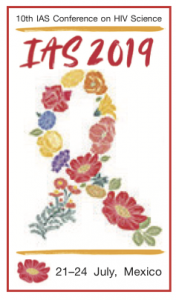Islatravir (MK-8591) with doravirine plus lamivudine: 24 week results
24 July 2019. Related: Conference reports, Antiretrovirals, IAS 10 Mexico City 2019.
 Simon Collins, HIV i-Base
Simon Collins, HIV i-Base
New results using the investigational nucleoside reverse transcriptase translocation inhibitor (NRTTI) MK-8591 – recently named islatravir – was the focus of several presentations at IAS 2019.
One of these included 24-week results in a new FDC coformulated with doravirine and lamivudine (3TC). It is notable that this study also includes a switch to islatravir/doravirine dual therapy (at week 24). [1]
This is a phase 2b, randomised, double-blind, placebo-controlled, dose-ranging study in treatment-naïve participants with an active control arm using an FDC of doravrine/3TC/TDF.
The study randomised 121 treatment-naïve participants (1:1:1:1) to one of three doses for islatravir (0.25, 0.75, or 2.25 mg) plus doravirine (100 mg) and 3TC (300 mg) for at least the first 24 weeks, or to doravirine/3TC/TDF, with appropriate placebo.
Entry criteria included baseline CD4 count >200 cells/mm3 and viral load ≥1,000 copies/mL. The primary efficacy endpoint is viral reductions at week 24. Participants with viral load <50 copies/mL at week-24 can discontinue 3TC and remain on dual therapy with islatravir plus doravirine.
Baseline characteristics included mean age 31 years, 93% male. Mean CD4 count was 492 cells/mm3 (SD: 188) and 22% had viral load >100.000 copies/mL.
Race included 76% white and 20% black but the study also referred to approximately half the participants being Hispanic or Latin American. Approximately 40% were treated in sites in North America, 30% in South American and 25% in Europe.
Mean viral load reductions at week-24 in the pooled islatravir arms was –2.9 log copies/mL (with no differences between doses) compared to –2.8 with doravirine/3TC/TDF. All groups also reported mean viral load reductions of –2 log copies/mL by week 2.
Viral load <50 copies/mL at week 24 were reported in 89%, 100%, 87% and 87% in the 0.25, 0.75, 2.25mg and control arm respectively. See Table 1.
Eleven participants did not achieve <50 copies/mL at week 24, mainly due to either low level viral load <200 copies/mL (n=5), missing data but previously < 50 copies/mL (n=2), or early study discontinuation (n=4). There were no cases of protocol defined failure (ie confirmed viral load > 200 copies/mL etc).
Tolerability was good with no serious drug-related AEs or discontinuations due to AEs. Common low grade side effects included diarrhoea, bronchitis and headache. One participants in the 0.7 mg arm reported abnormal dreams, fatigue, fever, abdominal distention and anxiety through to week 24 and one reported initial insomnia. One participant in the 2.25 mg arm reported insomnia through to week 24 and one reported rash. Two serious events were not judged treatment related: one facial paralysis and moderate dysentery (for 3 days at day 56).
Table 1: Viral load responses and side effects at week 24
| 0.25mg | 0.75 mg | 2.25 mg | doravirine/3TC/TDF | |
| n | 29 | 30 | 31 | 31 |
| <50 c/mL | 89% (26/29) | 100% (30/30) | 87% (27/31) | 87% (27/31) |
| BL <100K | 90% (20/22) | 100% (24/24) | 90% (20/22) | 88% (23/26) |
| BL >100K | 85% (6/7) | 100% (6/6) | 77% (7/9) | 80% (4/5) |
| Drug-related AEs | 0% (0/29) | 7% (2/30) | 7% (2/31) | 19% (6/31) |
| Serious AE | 0% | 3% (1) | 0% | 1% (1) |
Nearly all participants switched to two-drug islatravir plus doravirine at week-24 and these results will be added to this report after they are presented at IAS 2019 in two days time. [2]
Another late-breaker abstract reported on a long-acting slow-release implant formulation of islatravir that produced sustained drug levels for more than one year. This will be reported in a separate article. [3]
Islatravir is in development at Merck (MSD), who also developed doravirine. Generic lamivudine is used in these FDCs.
References
- Molina J-M et al. Tolerability, safety and efficacy of MK-8591 at doses of 0.25 to 2.25 mg QD, in combination with doravirine and lamivudine through 24 weeks in treatment-naïve adults with HIV-1 infection. 10th IAS Conference on HIV Science (IAS 2019), 21-24 July 2019, Mexico City. Late breaker post abstract LBPED46.
http://programme.ias2019.org/Abstract/Abstract/4694 - Molina J-M et al. MK-8591 at doses of 0.25 to 2.25 mg QD, in combination with doravirine establishes and maintains viral suppression through 48 weeks in treatment-naïve adults with HIV-1 infection. 10th IAS Conference on HIV Science (IAS 2019), 21-24 July 2019, Mexico City. Late breaker oral abstract WEAB0402LB.
http://programme.ias2019.org/Abstract/Abstract/4789 - MatthewsRP et al. First-in-human trial of MK-8591-eluting implants demonstrates concentrations suitable for HIV prophylaxis for at least one year.10th IAS Conference on HIV Science (IAS 2019), 21-24 July 2019, Mexico City. Late breaker post abstract TUAC0401LB.
http://programme.ias2019.org/Abstract/Abstract/4843

